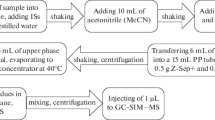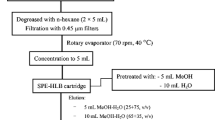Abstract
A new simple analytical method for monitoring propyl propane thiosulfonate (PTSO) in animal feed is presented. PTSO is an active ingredient from Allium spp. (like onion and shallot), proposed as a natural additive for feed being an efficient alternative to antibiotics used as growth promoter due to its efficiency improving animal health. Reversed-phase liquid chromatography with UV detection has been used and a previous sample treatment based on solid-liquid extraction has been developed and optimized in order to extract PTSO from a feed for laying hens using acetone as extraction solvent. The method has been characterized obtaining limits of detection and quantification of 11.2 and 37.3 mg kg−1, respectively, which are lower than the concentrations expected in samples containing this additive. The intra- and interday relative standard deviations (RSDs) were lower than 8.3 % in all the cases, and recoveries varied from 90.2 to 94.6 %. Finally, in order to check the unequivocal identification of PTSO, mass spectrometry detection was applied. The proposed method is a simple procedure for monitoring PTSO in commercial feed, being possible to implement it in routine laboratories for quantification purposes and stability studies of the distributed products.


Similar content being viewed by others
References
Ankri S, Mirelman D (1999) Antimicrobial properties of allicin from garlic. Microbes Infect 1:125–129
Block E (1992) The organosulfur chemistry of the genus Allium—implications for the organic-chemistry of sulfur. Angew Chem Int 31:1135–1178
Blumenthal M, Goldberg A, Brinckmann J (2000) Herbal medicine: expanded commission E monographs. Integrative Medicine Communications, Newton
Brambilla G, De Filippis S (2005) Trends in animal feed composition and possible consequences on residue tests. Anal Chim Acta 529:7–13
Cavallito C, Bailey J (1944) Allicin, the antibacterial principle of Allium sativum. Isolation, physical properties and antibacterial action. J Am Chem Soc 66:1944–1952
Chun S-S, Vattem DA, Lin Y-T, Shetty K (2005) Phenolic antioxidants from clonal oregano (Origanum vulgare) with antimicrobial activity against Helicobacter pylori. Process Biochem 40:809–816
Costa L, Panhoza MT, Miyada VS (2007) Herbal extracts as alternatives to antimicrobial growth for weanling pigs. Braz J Anim Sci 36:589–595
European Commission (2003) Regulation (EC) No 1831/2003 of the European Parliament and of the Council of 22 September 2003 on additives for use in animal nutrition. Official Journal of the European Union L262 (18.10.2003)
Friedman M, Henika PR, Mandrell RE (2002) Bactericidal activities of plant essential oils and some of their isolated constituents against Campylobacter jejuni, Escherichia coli, Listeria monocytogenes, and Salmonella enterica. J Food Prot 65:1545–1560
Kim DK, Lillehoj HS, Lee SH, Lillehoj EP, Bravo D (2012) Improved resistance to Eimeria acervulina infection in chickens due to dietary supplementation with garlic metabolites. Br J Nutr 109:1–13
Kuo M, Ho C (1992) Volatile constituents of the solvent extracts of. Welsh onions (Allium fistulosum L. variety Maichuon) and scallions (A. fistulosum L. variety Caespitosum). J Agric Food Chem 40:1906–1910
Liu G et al (2008) Effects of herbal extract supplementation on growth performance and insulin-like growth factor (IGF)-I system in finishing pigs. J Anim Feed Sci 17:538–547
Magi E, Jarvis T, Miller I (2006) Effects of different plant products against pig mange mites. Acta Vet Brno 75:283–287
Namkung H et al (2004) Impact of feeding blends of organic acids and herbal extracts on growth performance, gut microbiota and digestive function in newly weaned pigs. Can J Anim Sci 84:697–704
Oetting L et al (2006) Effects of herbal extracts and antimicrobials on apparent digestibility, performance, organs morphometry and intestinal histology of weanling pigs. Braz J Anim Sci 35:1389–1397
Peinado MJ, Ruiz R, Echávarri A, Rubio LA (2012) Garlic derivative PTS-O is effective against broiler pathogens in vivo. Poult Sci 91:2148–2157
Peinado MJ, Ruiz R, Echavarri A, Aranda-Olmedo I, Rubio LA (2013) Garlic derivative PTS-O modulates intestinal microbiota composition and improves digestibility in growing broiler chickens. Anim Feed Sci Technol 181:87–92
Ruiz R, García M, Lara A, Rubio L (2010) Garlic derivatives (PTS and PTS-O) differently affect the ecology of swine faecal microbiota in vitro. Vet Microbiol 144:110–117
Suhr KI, Nielsen PV (2003) Antifungal activity of essential oils evaluated by two different application techniques against rye bread spoilage fungi. J Appl Microbiol 94:665–674
Utiyama CE, Oetting LL, Giani PA, Ruiz UDS, Miyada VS (2006) Effects of antimicrobials, prebiotics, probiotics and herbal extracts on intestinal microbiology, diarrhea incidence and performance of weanling pigs. Braz J Anim Sci 35:2357–2359
Acknowledgements
The authors are thankful for the financial support from the Campus of International Excellence – BioTic Granada (Project CEI2013-MP-27). NAM thanks the Junta the Andalucía for a postdoctoral contract.
Conflict of Interest
Paloma Abad declares that he has no conflict of interest. Francisco J. Lara declares that he has no conflict of interest. Natalia Arroyo-Manzanares declares that he has no conflict of interest. Alberto Baños declares that he has no conflict of interest. Enrique Guillamón declares that she has no conflict of interest. Ana M. García-Campaña declares that she has no conflict of interest. This article does not contain any studies with human or animal subjects.
Author information
Authors and Affiliations
Corresponding author
Rights and permissions
About this article
Cite this article
Abad, P., Lara, F.J., Arroyo-Manzanares, N. et al. High-Performance Liquid Chromatography Method for the Monitoring of the Allium Derivative Propyl Propane Thiosulfonate Used as Natural Additive in Animal Feed. Food Anal. Methods 8, 916–921 (2015). https://doi.org/10.1007/s12161-014-9952-1
Received:
Accepted:
Published:
Issue Date:
DOI: https://doi.org/10.1007/s12161-014-9952-1




